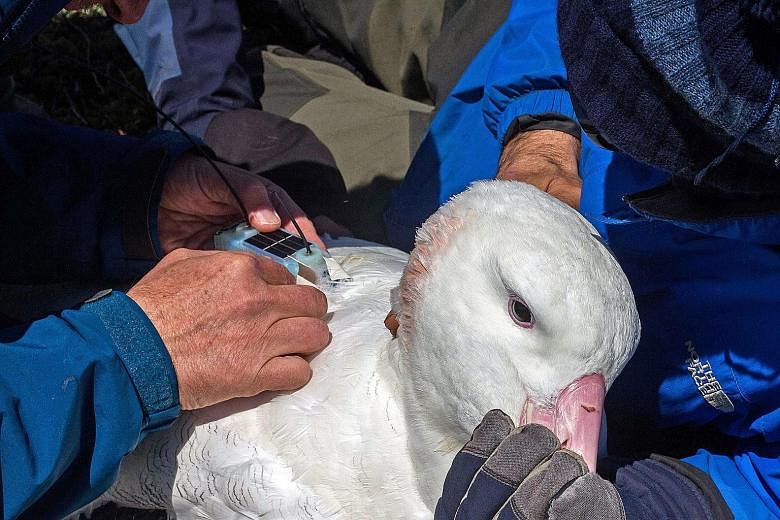NEW YORK • There is a lot of ocean out there, and ships engaging in illegal fishing or human trafficking have good reason to hide.
But even the stealthiest vessels - the ones that turn off their transponders - are not completely invisible: albatrosses, outfitted with radar detectors, can spot them, new research has shown.
A lot of ships may be trying to disappear. Roughly a third of vessels in the southern Indian Ocean were not broadcasting their whereabouts, the bird patrol revealed.
Albatrosses are ideal sentinels of the open ocean, said Dr Henri Weimerskirch, a marine ecologist from the French National Centre for Scientific Research in Chize, France, and the lead author of the new study published on Monday in the Proceedings Of The National Academy Of Sciences journal.
"They are large birds, they travel over huge distances and they are very attracted by fishing vessels," he said.
Dr Weimerskirch and his colleagues visited albatross breeding colonies on the Amsterdam, Crozet and Kerguelen islands - French outposts in the southern Indian Ocean. The team attached data loggers weighing roughly 57g to 169 adult and juvenile birds. The equipment consisted of a Global Positioning System antenna, a radar detector and an antenna for transmitting data to a group of satellites.
It took two people about 10 minutes to tape a solar-powered logger onto the back feathers of an albatross. Despite the birds' size - the largest one the researchers handled tipped the scales at 11.8kg - they were very easy to work with, said Dr Weimerskirch.
From November 2018 to last May, the researchers watched as breeding adults foraged at sea for 10 to 15 days at a time, flying thousands of miles in each trip, and as juveniles left the colony. The birds traversed an area of roughly 47 million sq km, about five times the size of the United States, always on the lookout for radar signals.
Fishing boats are regularly in those waters, seeking tuna and Patagonian toothfish - otherwise known as Chilean sea bass - that frequent areas near the islands.
The feathery dragnet recorded radar blips from 353 vessels which used radar to navigate and detect other craft. But only 253 of the vessels had their automatic identification system (AIS) transponders turned on. An AIS transponder broadcasts a ship's identity, position, course, speed and other information, as required by International Maritime Organisation regulations.
One hundred ships, or 28 per cent, were silent.
They might have been fishing without a licence or transferring illegal catches onto cargo vessels, Dr Weimerskirch said. "A lot of fishing boats prefer not to be located."
When the researchers looked only at ships in international waters, they found an even higher percentage, or 37 per cent, of stealth vessels. There have been no previous estimates of vessels evading detection, Dr Weimerskirch said, adding: "It's a surprise that the number is so high."
These observations can help government officials pinpoint suspicious vessels, the team suggested, because both the birds' radar detection and AIS information can be downloaded almost in real time.
Dr Daniel Pauly, a fisheries biologist from the University of British Columbia who was not involved in the research, said the use of the technology was a "real achievement".
Dr Weimerskirch and his colleagues are planning similar investigations in places such as New Zealand, Hawaii and South Georgia, an island in the southern Atlantic Ocean. They hope to show that other species of seabirds, like petrels, can also be ocean sentinels.
The first step is to make the equipment smaller, Dr Weimerskirch said. "We're working on miniaturising the loggers."
NYTIMES

